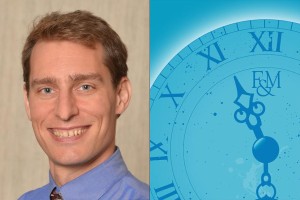Izzy Schellenger || Staff Writer

This week’s Common Hour lecture featured Christopher Fitz, the Executive Director of the Center for Community Peacemaking. The Center for Community Peacemaking was founded in 1994 in Lancaster, PA as a way to peacefully deal with crimes committed by juvenile offenders. Since being founded, the program has successfully used restorative justice for more than 10,000 people in Lancaster County.
Fitz graduated from Hampshire College with a B.A. in Peace and Conflict Studies. He later received his M.A. in International Peace and Development Studies from the Universitat Jaume I in Castellon, Spain. He has led the Lancaster Area Victim Offender Reconciliation Program in the Center for Community Peacemaking since 2014. His Common Hour lecture focused on raising awareness for this program and on the benefits of restorative justice.
Fitz began his lecture by describing what happened when two people burned down his family’s barn when he was eight years old. The men tried to siphon gasoline from the barn into their car, and they used a cigarette lighter in order to see, which ended up setting the barn on fire. Instead of having these two people go to jail or pay a fine, Fitz’s parents chose a different course of action.
“Why don’t these people just apologize and help us rebuild the barn?” they thought.
This reaction sparked Fitz’s interest in helping to develop a practical response to crime that would give the victims and the offenders an opportunity for emotional and moral growth. When he was eight, Fitz met the people who burned down his barn. He learned what poverty is like and how it can drive people to do the unthinkable in order to survive. After this one-on-one encounter, Fitz’s family and the offenders left feeling better about the situation because they were able to get some answers and receive closure.
If he had not talked with the offenders, Fitz would not have known what emotional and fiscal stress that the offenders were going through. He compared this lack of knowledge to what he labeled as the “iceberg of social crises.” At the tip of the iceberg, there is public crime, which is what people only see on the surface. Underneath this, however, there is a private, personal life and conflict that outsiders don’t see.
With restorative justice, people benefit from finding out facts to fill in the blanks of what lies beneath the tip of the iceberg. Fitz compare restorative and community justice to state and retributive justice– with retributive justice, you will not find out what lies underneath the iceberg. State justice takes a more universalistic approach to crime and is punishment-driven. It makes a public spectacle of crime and creates feelings of shame. Retributive justice sees crimes as crimes against the state, and it asks questions such as “What law was broken?,” “Who did it?,” and “What do they deserve?” In comparison, community justice responds in much more decentralized and privatized ways, asking questions such as “Who was harmed?” and “What are their needs?” Restorative justice sees crime as a crime against real people.
Restorative justice allows the victim to confront the offender, ask questions, and seek closure. In this way, the victim has a sense of control over the situation and they can see the offender as an actual person, since offenders are usually dehumanized. The Lancaster Area Victim Offender Reconciliation Program offers three programs of restorative justice, including victim-offender conferencing, conflict resolution workshops, and peacemaking circles for communities. According to Fitz, people leave these programs with 90 percent satisfaction, and the juvenile recidivism rate has decreased to 14 percent from 28 percent from 2007 to 2011.
Fitz ended his lecture by telling a story about two boys who stole tires from an auto-mechanic’s front yard. Through this restorative justice program, the victim became a type of mentor to the offenders, as the victim-offender conferencing led to the discovery that these boys wanted to be auto-mechanics too. This is reflective of what restorative justice means to Fitz. By applying a more practical response to crime, the victims and the offenders are able to understand, learn, and communicate, which leads to a brighter future for the offenders.
At the end of his lecture, Fitz quoted Rumi: “Out beyond ideas of wrongdoing and rightdoing there is a field. I’ll meet you there.” He asked us to consider what we want our backyard, community, and neighborhood to look like. Through restorative justice and compromise, Fitz believes we can improve our community.
Sophomore Izzy Schellenger is a staff writer. Her email is ischelle@fandm.edu